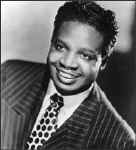
Jump Blues developed in the late '30s among the swing bands of Count Basie, Cab Calloway, Erskine Hawkins, Lionel Hampton, and Lucky Millinder. However, it was several smaller post-World War II combos that popularized the style. The prime purveyor of jump blues and its most successful practitioner, Louis Jordan enjoyed enormous success, both in the R&B and pop fields, between 1942 and 1951.
By the second half of the '40s, jump blues had become the dominant form of black popular music. Among its successful practitioners were Joe and Johnny Liggins, Roy Milton and his Solid Senders with boogie woogie pianist Camille Howard, Amos Milburn, and in the '50s Italian vocalist Louis Prima with Sam Butera and the Witnesses.

Tiny Bradshaw was one of the most prominent bandleaders of the '30s and '40s who led
groups of essentially jazz - trained musicians into the developing (and more commercial)
field that came to be known as rhythm & blues. A vocalist with other bands early in
his career, Bradshaw formed his own band in 1934 and kept it going through the early '50s,
enjoying five Billboard hits (and also recording the original "Train Kept A
-Rollin'") with King Records (where he was a labelmate to many of the other leading
jump blues performers of the era). Bradshaw's band produced such saxophone stars as Sonny
Stitt, Red Prysock, and Sil Austin; among the vocalists to record with the group were Roy
Brown, Arthur Prysock, Lonnie Johnson, and Tiny Kennedy. - - Jim O'Neal , All-Music Guide

When you draw up a short list of the R&B pioneers who exerted a primary influence on the development of rock & roll, respectfully place singer Roy Brown's name near its very top. His seminal 1947 DeLuxe Records waxing of "Good Rockin' Tonight" was immediately ridden to the peak of the R&B charts by shouter Wynonie Harris and subsequently covered by Elvis Presley, Ricky Nelson, Jerry Lee Lewis, and many more early rock icons (even Pat Boone!). In addition, Brown's melismatically pleading, gospel - steeped delivery impacted the vocal styles of B.B. King, Bobby Bland, and Little Richard (among a plethora of important singers). Clearly, Roy Brown was an innovator - - and from 1948 - 1951, an R&B star whose wild output directly presaged rock's rise. Born in the Crescent City, Brown grew up all over the place: Eunice, LA (where he sang in church and worked in the sugarcane fields), Houston, TX, and finally Los Angeles by age 17. Back then, Bing Crosby was Roy's favorite singer - - but a nine - month stint at a Shreveport, LA nightclub exposed him to the blues for the first time. He conjured up "Good Rockin' Tonight" while fronting a band in Galveston, TX. Ironically, Harris wanted no part of the song when Brown first tried to hand it to him. When pianist Cecil Gant heard Brown's knockout rendition of the tune in New Orleans, he had Roy sing it over the phone to a sleepy DeLuxe boss, Jules Braun, in the wee hours of the morning! Though Brown's original waxing (with Bob Ogden's band in support) was a solid hit, Harris's cover beat him out for top chart honors. Roy didn't have to wait long to dominate the R&B lists himself. He scored 15 hits from mid - 1948 to late 1951 for DeLuxe, ranging from the emotionally wracked crying blues "Hard Luck Blues" (his biggest seller of all in 1950) to the party- time rockers "Rockin' at Midnight," "Boogie at Midnight," "Miss Fanny Brown," and "Cadillac Baby." Strangely, his sales slumped badly from 1952 on, even though his frantic "Hurry Hurry Baby," "Ain't No Rockin' No More," "Black Diamond," and "Gal from Kokomo" for Cincinnati's King Records rate among his hottest houserockers. Brown was unable to cash in on the rock & roll idiom he helped to invent, though he briefly rejuvenated his commercial fortunes at Imperial Records in 1957. Working with New Orleans producer Dave Bartholomew, then riding high with Fats Domino, Brown returned to the charts with the original version of "Let the Four Winds Blow" (later a hit for Fats) and cut the sizzling sax -powered rockers "Diddy - Y - Diddy - O," "Saturday Night," and "Ain't Gonna Do It." Not everything was an artistic triumph; Brown's utterly lifeless cover of Buddy Knox's "Party Doll" - amazingly, a chart entry for Brown - - may well be the worst thing he ever committed to wax (rivaled only by a puerile "School Bell Rock" cut during a momentary return to King in 1959). After a long dry spell, Brown's acclaimed performance as part of Johnny Otis's troupe at the 1970 Monterey Jazz Festival and a 1973 LP for ABC - BluesWay began to rebuild his long - lost momentum. But it came too late - - Brown died of a heart attack in 1981 at age 56, his role as a crucial link between postwar R&B and rock's initial rise still underappreciated by the masses. - - Bill Dahl, All-Music Guide